
The Entropy Law still matters. CUSP director Tim Jackson responds to Michael Liebreich’s essay on the ‘The secret of eternal growth’. (This blog first appeared on the CUSP website, 4 November 2018.)
It’s probably fitting that Michael Liebreich’s The Secret of Eternal Growth was published so close to Halloween. It’s so full of outlandish bogeymen, it sits perfectly alongside the ghouls and the ghosts of the trick-or-treat season.
The thrust of his article is very simple. Anyone who questions the wisdom of eternal growth on a finite planet is a mindless, anti-capitalistic, left-leaning fraud who has abandoned ‘hard measurement’ and practises ‘fake science’. (I think I captured all the accusations but it’s hard to be sure.) Trash them, one and all, these unruly critics of late capitalism.
It’s a surprising ad personam rant, based on a flagrant disrespect for anyone taking a contrary view. And it’s peppered with an unhealthy dose of outright hubris, typified by a glowing endorsement of Ronald Reagan’s Hollywood B-list mantra: ‘there are no such things as limits to growth, because there are no limits on the human capacity for intelligence, imagination, and wonder’. The music swells, our hero lifts his gaze, the camera pans away, across the wide savannah.
I laughed out loud when I read that finale. I laughed again at Liebreich’s lavish claim that it displayed ‘a more thorough understanding of thermodynamics and economics than the entire degrowth crowd’. I laughed because I use this exact same quote with my students, as an exercise in separating logic from fallacy, in the question of limits. But I’ll come back to that later.

I should really start, shouldn’t I, by trashing my opponent’s credentials? Science is just a trick or treat parade. Let’s bring out the undead. Wouldn’t it be great if Liebreich was just another arrogant, right-wing, free-market, pro-trade, growth-obsessed elitist with no real grounding in science? Well. He might be some of those things. But when it comes to thermodynamics, at least, he’s no zombie.
Here’s a fun fact. He and I both studied thermodynamics at university, he as an engineer and I as a mathematician. By an even quirkier turn of fate, it turns out we studied in the same place (Christ’s College, Cambridge) at more or less the same time (he arrived there a year or so after I left). And, as it happens, we both weren’t too shabby at it. But let’s not turn this into a pissing contest. We clearly came out of it with rather different ideas about the world.
It may seem picky. But I still believe, naively perhaps, that scholarship matters. The secret of eternal growth doesn’t exactly distinguish itself in this regard. Its generosity towards the environmental Kuznets curve is uninformed. Its grasp of carbon accounting is tenuous at best. Its attempted takedown of Jay Forrester displays all the mistakes that have haunted the Limits to Growth debate. But the crowning glory of the ghouls parade, and of course the thing that is absolutely meant to draw blood, is the claim that ‘when you scratch the surface of any of the seminal tracts of the degrowth movement, you find they are based on the same fake science, right through to the present day’.
The source of this supposedly fake science is a 1971 book called The Entropy Law and the Economic Process written by the Romanian-born mathematician and economist Nicholas Georgescu-Roegen. Apparently, Georgescu-Roegen made the schoolboy error of mistaking planet Earth for an isolated thermodynamic system inaccessible to any inflow or outflow of energy instead of a closed system subject to a continuous inflow of high-quality solar energy. So says Liebreich.
But that’s not even remotely true.
I know this, because I went to The Entropy Law myself almost thirty years ago to support a proposal for a pioneering series of articles on renewable energy that I wanted to submit as guest editor to the journal Energy Policy. This was at a time when the very subject of solar power was still regarded in the UK as the concern of freaks, radicals and Danish people. Getting one paper on renewable energy into a mainstream energy journal was hard enough. Pitching a whole series of articles was positively risqué. But I managed to make my case. And I made it because of Georgescu-Roegen – with the help of Herman Daly, of course.
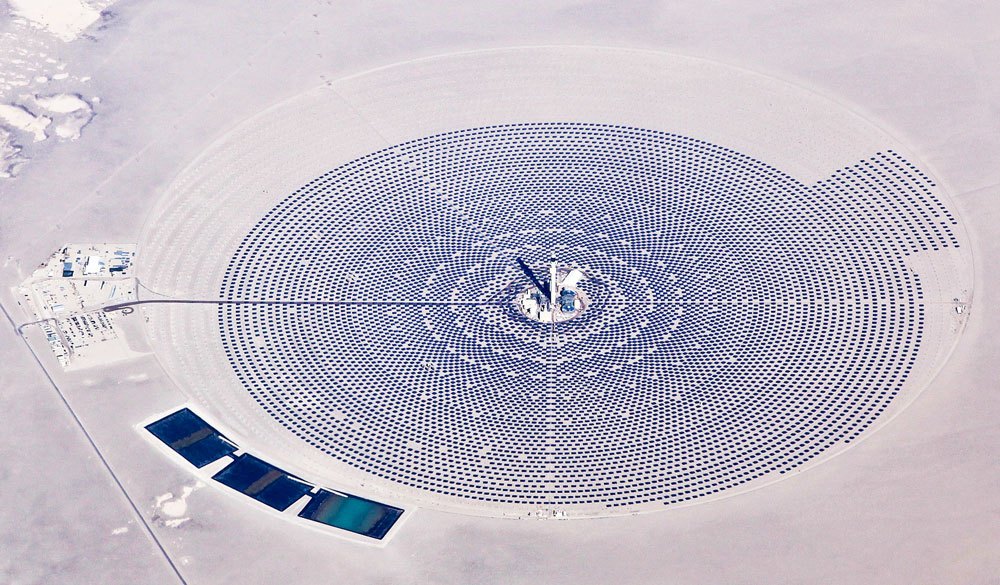
When I first read The Entropy Law, I have to confess I found it obtuse, eccentric almost, overly complex. It is notoriously hard to read. Herman Daly did the world a service not just in translating its core messages but in spelling out its implications for a steady state economy. Not degrowth in the simplistic sense of an economy where someone has found a dial that governs the size of the Gross Domestic Product (GDP) and managed to turn it down a notch. But an economy with a constant stock of capital, capable of being maintained by a rate of material and energy throughput that is within the regenerative and assimilative capacities of the ecosystem.
At no point in any of this does either Georgescu-Roegen or Herman Daly mistake the planet for an isolated thermodynamic system. The Entropy Law is very clear that there are two fundamental sources of high-quality energy on planet Earth ‘(1) the stock of low entropy on or within the globe and (2) the flow of solar energy.’ (This is from page 20, by the way, right at the start of the book.) It goes on to make the very point claimed for his own by Liebreich, that the relative magnitude of the latter dwarfs the magnitude of the former. ‘For, as surprising as it may seem, the entire stock of natural resources is not worth more than a few days of sunlight!’ (p21).
One of the principal arguments in The Entropy Law (and the one that proved so useful to my publishing project) is that our prospects for future development depend inherently on living within this solar inheritance. ‘In a different way from the past,’ the author writes, ‘[we] will have to return to the idea that [our] existence is a free gift from the sun’ (p 21). Georgescu-Roegen’s entire argument is in favour of replacing the depletion and consumption of fossil resources with an economy built around renewable ones.
Liebreich is right in one thing. When it comes to accessibility, Ilya Prigogine and Isabelle Stengers’ Order out of chaos, first published in 1984, is a far more elegant, accessible exposition of the thermodynamics of dissipative systems than The Entropy Law manages. But the insights of the former don’t fundamentally undermine the insights of the latter. On the contrary, the discussion in The Entropy Law clearly prefigures the ideas in Order out of chaos.
Economic activity is never just random creation of monetary value, argues Georgescu-Roegen, it is explicitly purposive activity; it aims to achieve certain material and social purposes. Purposive human activity, he reasons, must always have some energetic or material component: nutrition, mobility, thermal comfort, social standing. Even the ‘bots’ in Liebreich’s brave new digital world have some materiality. Material transformations involve broadly thermodynamic processes – the transformation of energy from one state to another.
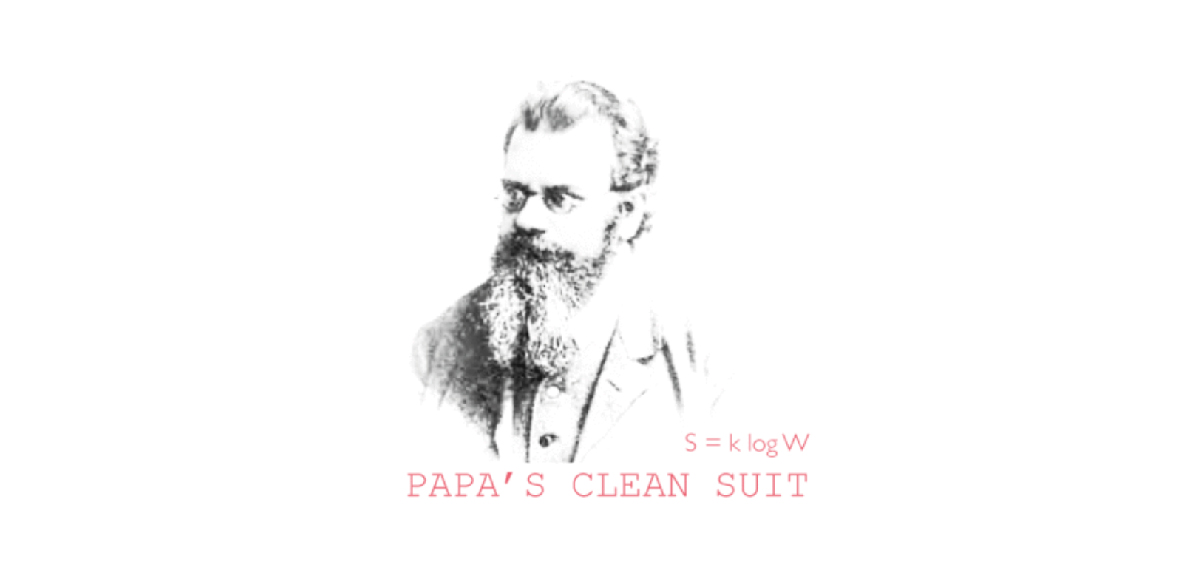
The second law of thermodynamics suggests that such processes are inherently dissipative. High-quality energy is transformed into low-quality energy in the process. ‘All our important purposes,’ concludes Georgescu-Roegen, ‘namely, to stay alive and to keep a place under the social sun – lead to entropic transformations of our neighbouring universe.’ Nothing in non-equilibrium thermodynamics contradicts this insight. Phenomenal, unanticipated order is possible, argues Prigogine, but only at the expense of an increase in entropy overall.
He may not be the most accessible writer, but Georgescu-Roegen is not the villain. And it’s painful to see him and those who learnt from him (like Herman Daly) vilified by arrogant posturing. The process of the advance of scientific understanding has few reputational safeguards for those honestly engaged along the way. But one of them, one that should continue to matter, is accurate and appropriate citation. The claim that The Entropy Law simply mistakes the Earth for an ‘isolated’ system, ignoring the vast solar inheritance received on an ongoing basis, is just shoddy scholarship.
So why exactly does Liebreich see fit to trash the reputation of the very people who provided the vision for the renewable energy world he claims he wants to see?
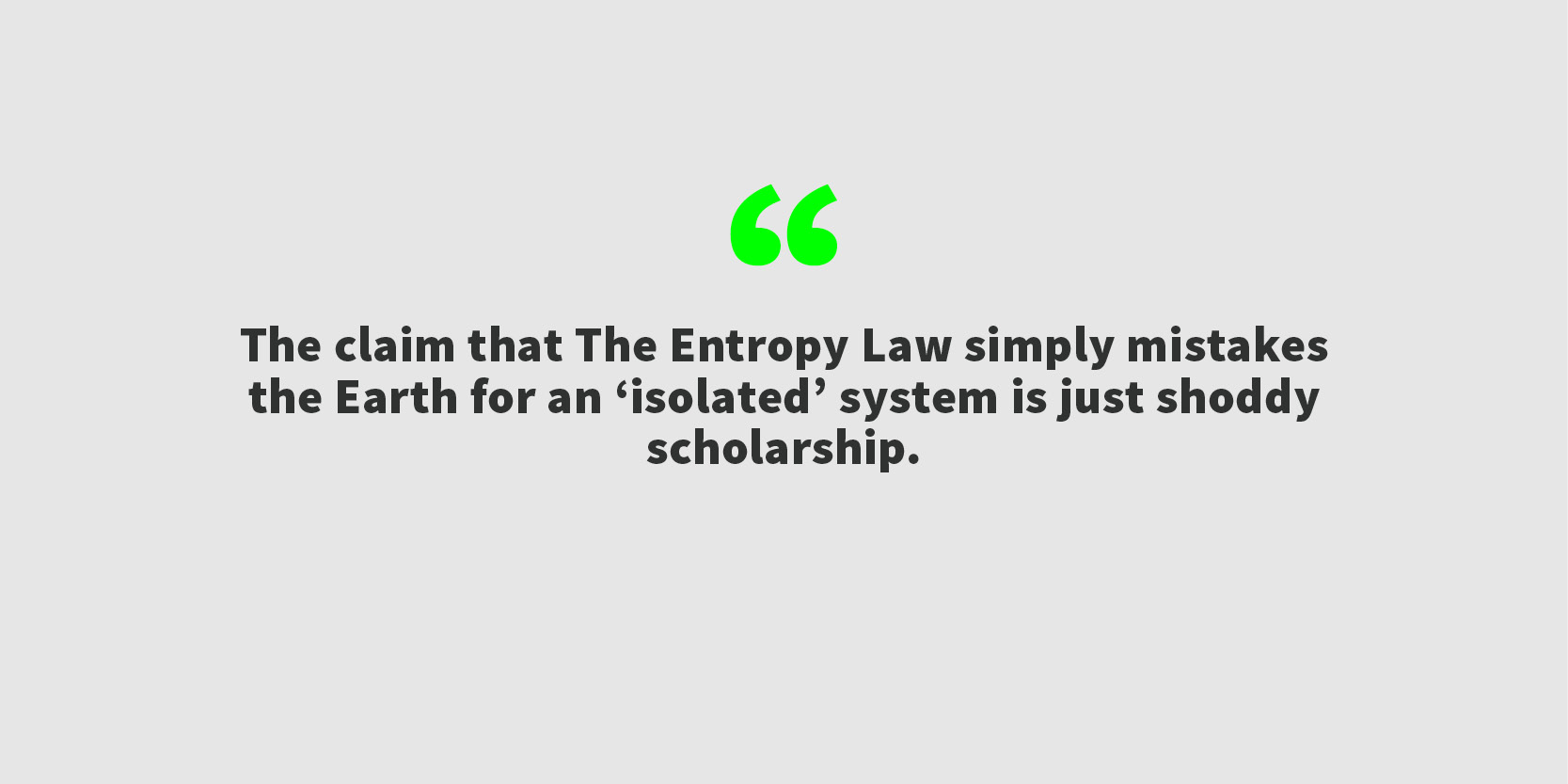
What’s mostly at stake here is the extent to which it is possible to ‘decouple’ the economy as a system of monetary flows from the economy as a set of material and energy (and carbon) flows. Liebreich’s argument is that it is infinitely (eternally) possible to do this. Georgescu-Roegen, Herman Daly and (as it happens) my argument is that it is not.
Clearly we don’t agree on that. But that is not because the ‘degrowth crowd’ is so stupid that it simply doesn’t understand that economic value is not the same thing as material throughput. The idea that critics of economic growth wilfully confuse the monetary economy with the material and energy economy is a very common bogeyman. One of the most colourful in the trick or treat parade. But it has little basis in reality. Certainly, neither Georgescu-Roegen nor Herman Daly ever remotely made that mistake.
They both argue in favour of decoupling economic output from its material throughput. They also warn against simplistic assumptions that such decoupling is trivial. Historical evidence would certainly support that warning. Absolute decoupling of carbon emissions from economic output, for example, isn’t anything like so prevalent as Liebreich believes it is. In the UK, even Defra now accept that on a consumption basis (ie taking into account the offshoring of industry) carbon emissions in the UK have risen rather than fallen since the 1990s.
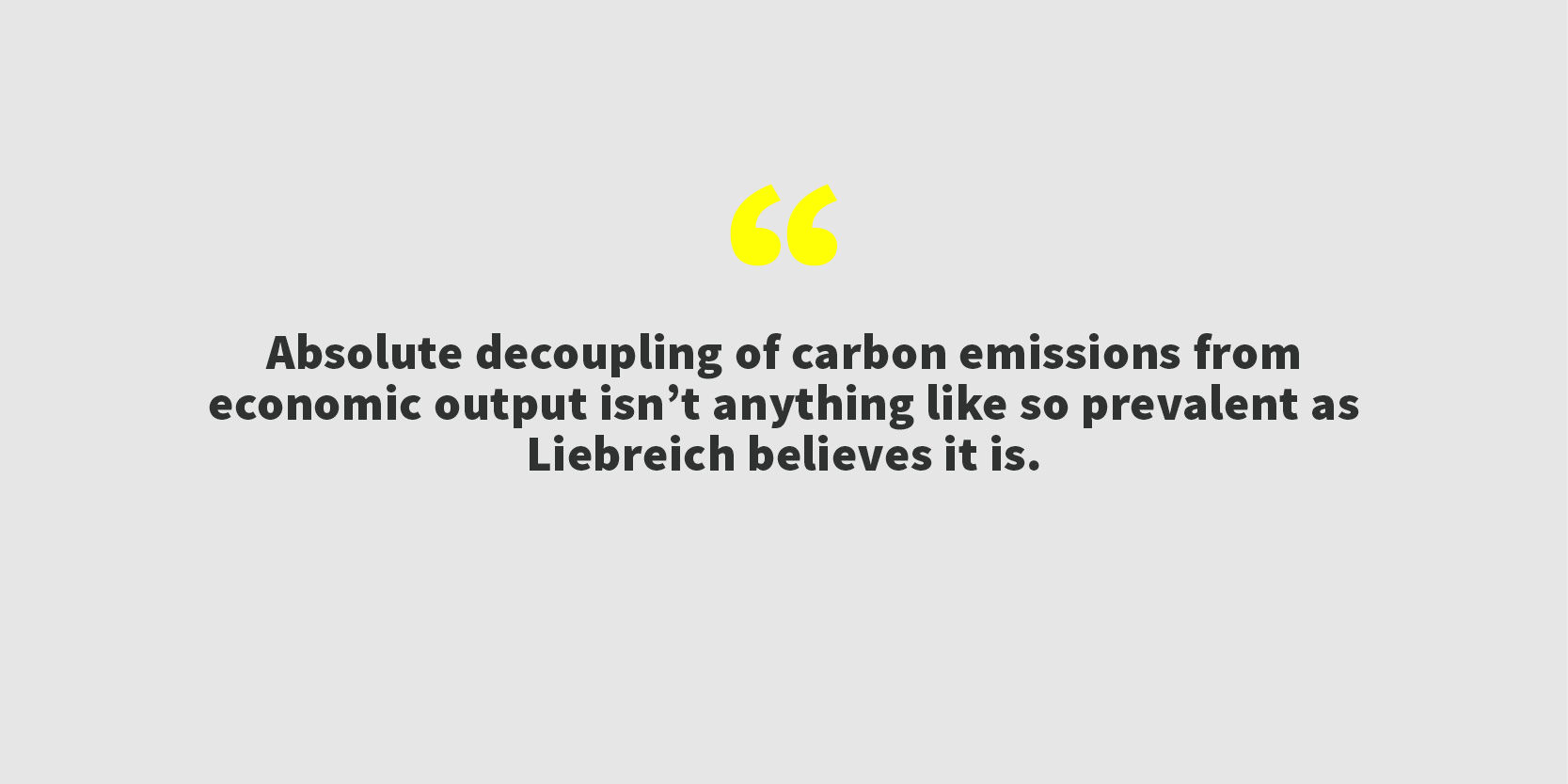
Some relative decoupling (a decline in the carbon intensity of economic activity) has clearly taken place. The carbon associated with a dollar of global economic output, for example, has declined by 35% over the last half a century. And this is entirely consistent with a system in which entrepreneurs prize efficiency and seek to minimise costs.
But global economic output has increased five-fold over the same period, swamping those efficiency gains by a substantial margin. Annual carbon emissions are more than three times what they were fifty years ago. The rate of de-carbonisation needed to deliver an emissions pathway capable of meeting the 1.5o target is an order of magnitude higher than anything that has ever been achieved historically.
None of this means that a 100% renewable energy world is impossible. But what Liebreich needs to pull off his conjuring trick of eternal growth in this renewable world is that every single dollar or cent of economic activity has a diminishingly small material footprint in perpetuity. This is precisely where Georgescu-Roegen and Herman Daly’s insights become important. We have to get beyond the simplistic maths of the planet’s energy balance if we want to understand why the solar energy flux remains so elusive.
Georgescu-Roegen attempted to do exactly this. In his 1975 paper on Energy and economic myths he identifies the challenge clearly. Despite its energetic magnitude, ‘the flow of solar energy comes to us with an extremely low intensity, like a fine rain, almost a microscopic mist,’ he points out (p371). To be useful this energy must be concentrated and captured. To be captured we must use materials, the availability of which depends in its turn on high-quality energy. The solar flux is free. But capturing it has a cost, in terms of materials, in terms of energy, and in terms of economic resources. The Entropy Law proposes a very specific ‘flow-fund’ model of the economy that is still being used today to get a better handle on that challenge.
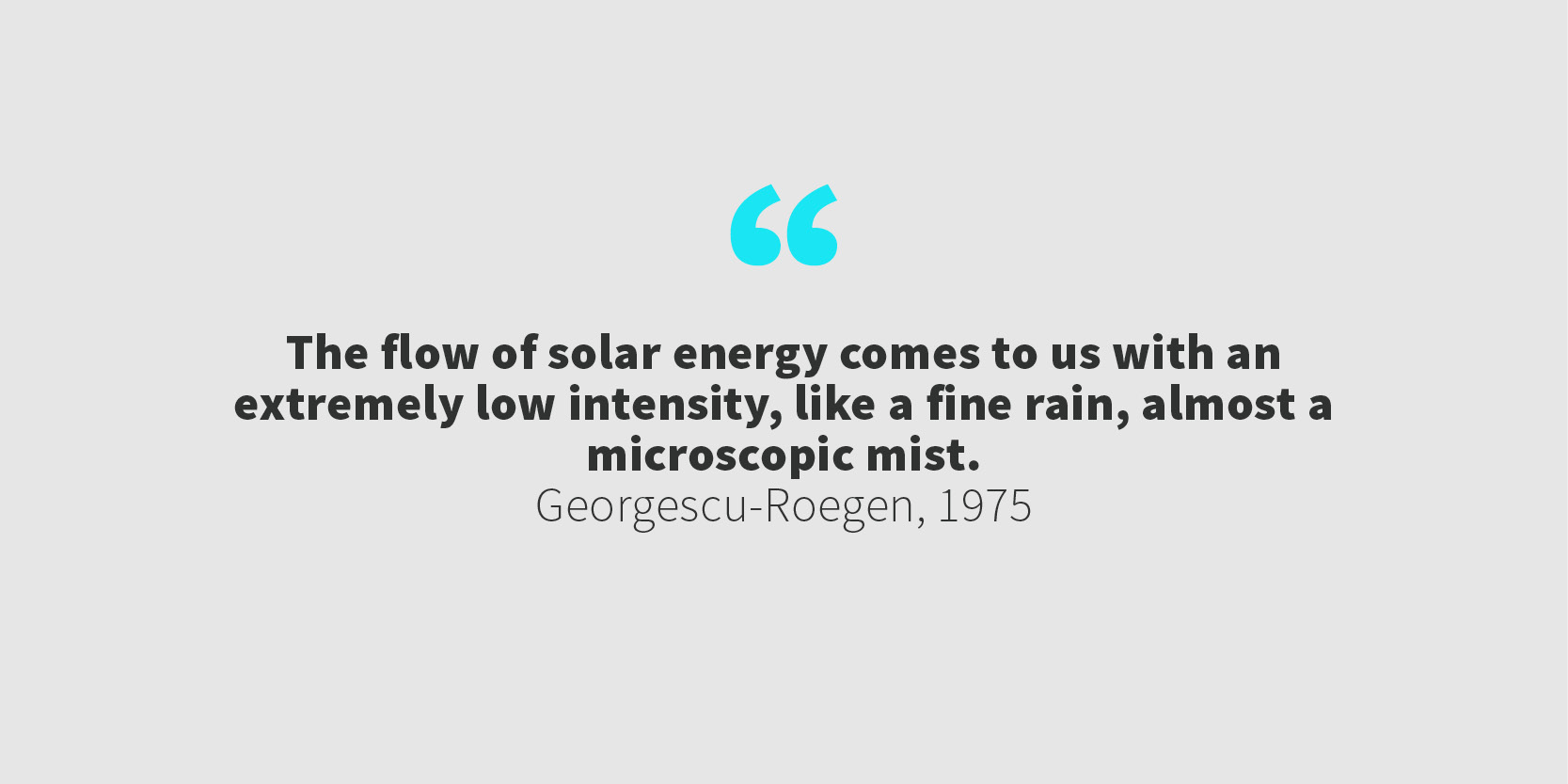
It still isn’t clear that this immediately rules out some form of growth. But it’s clear that the larger the economy becomes the more difficult it is to decouple that growth from its material impacts. We don’t even need thermodynamics to make this point. A bigger economy implies a bigger capital stock. A bigger capital stock means higher depreciation. An infinite economy (the ultimate outcome from eternal growth) means infinite depreciation. Infinite maintenance costs.
There’s a reason why financial depreciation is hardwired into standard accounting practices at both corporate and national level. Left to their own devices in a sun-drenched world, physical assets tend to fall apart. Using them tends to accelerate that process. Iron turns to rust. Concrete turns to dust. Even silicon chips degrade over time. Some of these processes can be reversed, with sufficient high-quality energy. Others are to all intents and purposes irreversible. This is not some dubious fourth law of thermodynamics. But it is a feature of a biophysical world that is governed by non-equilibrium thermodynamics. Our understanding of the limits of that biophysical world was illuminated – and not obscured – by Georgescu-Roegen’s pioneering work.
Which brings us back I suppose to Ronald Reagan’s stirring evocation of the unlimited power of human intelligence, imagination and wonder. My students, generally speaking, agree with that part of the former President’s finest lines. Why should they not? Our ingenuity is not just legendary, it’s evolutionary. There’s very good evidence to show that it is partly responsible for, and certainly complicit in our enormous ‘success’ as species. A success which looks anything other than that, of course, for most other species on the planet.
But why should we not turn that intelligence, imagination and wonder to new and exciting purposes? To improving the efficiency of material cycles. To reducing the cost of renewable energy still further. To developing technologies that work in harmony with natural ecosystems rather than against them. Or perhaps towards a greater sense of material sufficiency. Towards an economy of care and craft and creativity. Towards concern for others. Towards better stewardship of the planet.
All of this is laudable. None of it can possibly justify the causal leap implicit in Reagan’s ‘because’. Because we are intelligent does not mean that there is no such thing as limits. We cannot usefully ‘imagine’ the available carbon budget to be bigger than it actually is. Our ‘wonder’ will not in itself preserve the species lost precipitously in recent decades in the relentless pursuit of eternal growth.
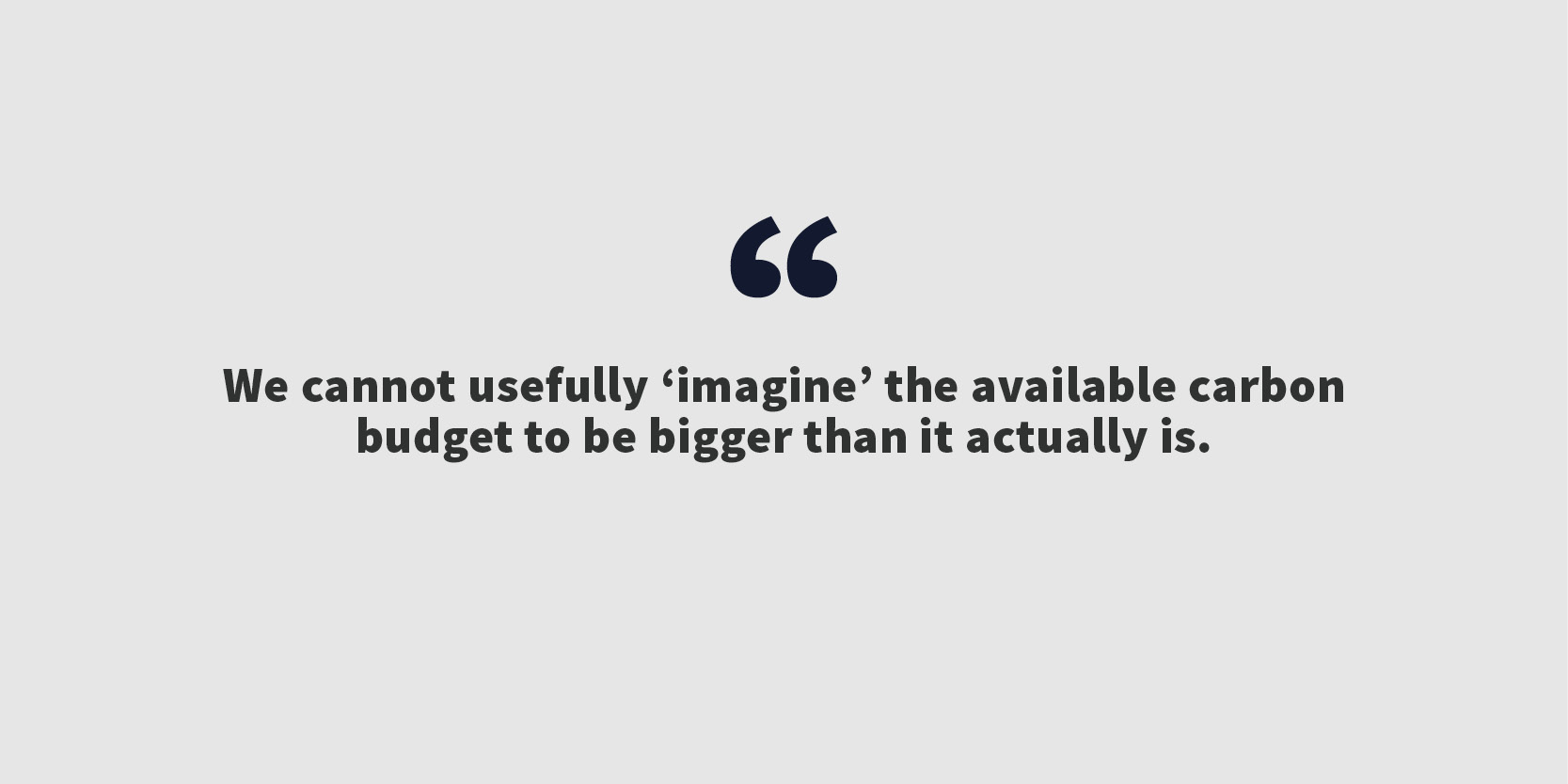
When I look back on The Entropy Law with the hindsight of almost three decades exploring that early vision, I see its author now in a different light. He is still to my mind something of an intellectual giant. But I can see more clearly, in his elliptical prose, the struggles of an ordinary scientist, engaged in messy scientific process.
There was, at the time he was writing, no ready-to-wear, off-the-shelf guide to the relevance of thermodynamics for economic activities. Thermodynamics didn’t much concern itself with economics. Economics certainly had no truck with thermodynamics. Georgescu-Roegen found himself stumbling, almost self-consciously, towards a new synthesis, a somewhat hesitant understanding of the biophysical reality of economic systems. It was a journey built around a process of endless conjectures and refutations: the very basis of good science according to the philosopher Karl Popper. Not fake science at all then, as Liebreich would have us believe. But the real thing.
There were cracks in his prose, for sure. Cracks in his arguments too perhaps. ‘There is a crack, a crack in everything.’ That’s how the light gets in.




